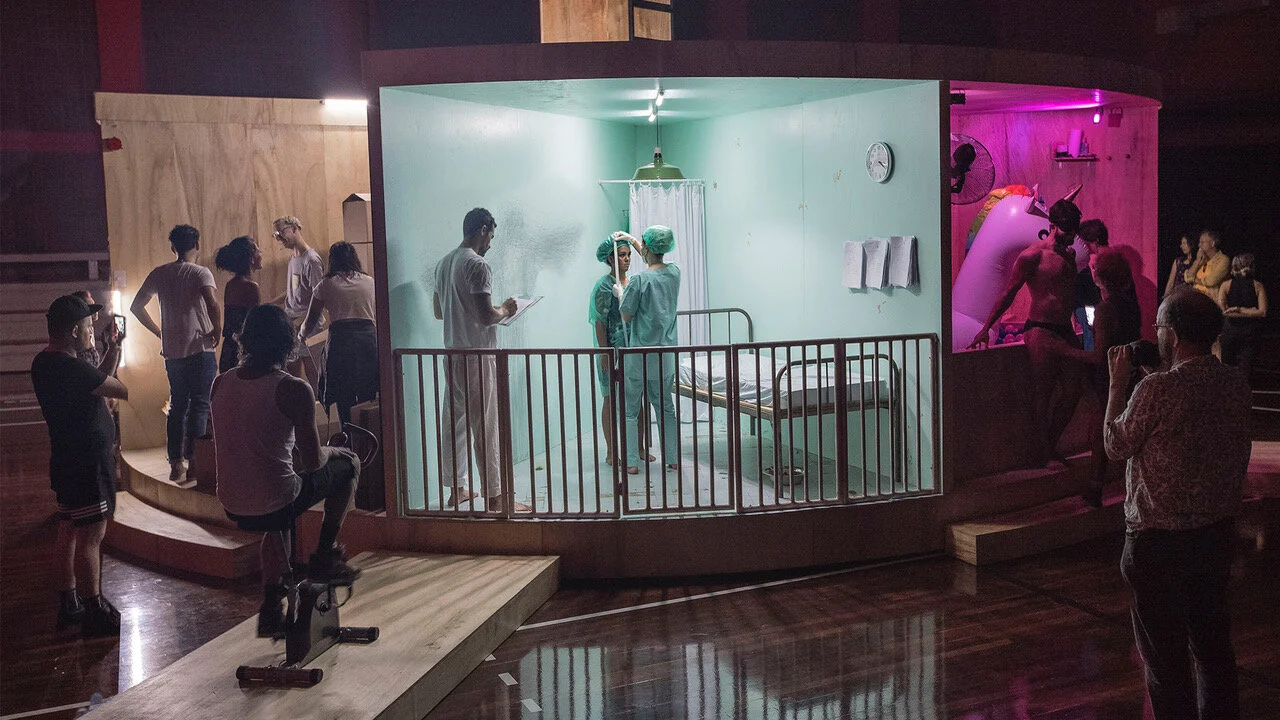Site-specific performative installation in collaboration with Evamaria Schaller, Anguezomo Mba Bikoro, Rafael Menôva, Jamie Lewis Hadley, PASHIAS, Clarissa Sacchelli, Guta Galli
Sesc Consolação, São Paulo, Brazil
Nov 6-20, 2017
Hours performed: 60
With Bruno Bezerra, Paula Thyse, Yara Howe, Daria Bobrenko, Jader Rocha Florencio
Curated by Margarita Osepyan
Executive Producer: Valeria Prata
Co-commissioned by Goethe-Institut, The British Council and Rosa Luxembourg Foundation
Installation by Atelier Marko Brajovic
Video Installation by Ilya Pusenkoff
Fyodor Pavlov-Andreevich Studio: Anna Shpilko (director), Alexandra Velichko (co-ordinator), Katya Petrova (assistant)
Images by Marcelo Elidio, Ilya Pusenkoff, Clarisse Tarran
Video by Ilya Pusenkoff
The Performance Carousel is a site-specific installation that responds to every new location, time frame, and context. Carousel Paulistano is the third edition of the project (the first one has been shown in 2014 at Faena Arts Center, Buenos Aires, and the second in 2016 at Künstlerhaus in Vienna) and its theme is Upside Down. It has 8 artists inside. It lasts for 12 days, 5 hours a day. The effect of The Carousel stays in visitor’s mind for at least 25 years (8+12+5).
Half of the participating artists are from São Paulo. Half from the rest of the world. Carousel’s rotation might well help them to answer the questions which have been successfully sorted out (or at least made rhetorical) at the peak of the history of performance art in Brazil in the 1970s with its powerful symbolism that played such an important role. Hopefully, it will continue now.
One of the crucial points of reference for The Carousel is The Narkomfin House (1930) in Moscow – 'a home to the new lifestyle' by architects Moissey Ginsburg and Ignatiy Milinis. It was inhabited by the staff of the Soviet Ministry of Finance, of all levels. There were no apartments but 'cells' used as work/living space. No private kitchens, only a communal one, and a dining area for all residents. No private showers, only toilets, and no bedrooms - but a communal dormitory with 1000 beds and a stage for an orchestra playing all night the music recommended by doctors to block the snoring. This utopian scheme didn't work from the start. Residents promptly started setting up their own showers, in the toilets, along with illegal stoves, installed in the washbasins. The Constructivist dream resulted in a boring fight for private space. Performance Carousel's artistic residents might experience similar problems of a different level sharing the non-stage with the fellow non-actors.
The purpose of The Performance Carousel is to set a precedent of a joint will and maybe even of an unconscious groupthink, while yet avoiding a collective brainstorming. The artists are separated by the walls; they agreed not to divulge the details of the works of the other performers; they enter/exit the museum space blindfolded. They represent a visual disunity which should help to find a trend, say it aloud and in unison, about what is today the nerve of earthly existence.
The São Paulo edition of Performance Carousel is a final part of The Episodes of South - a joint multidisciplinary project by Goethe-Istitut and SESC Sao Paulo - which is going to lead it to its grand finale.
Notion of South is a key element of the Episodes: geographically - the other part of the hemisphere and historically – colonization and the cultural, social and political issues as a result of this colonization. South is located in the bottom of the map. South is hot. But South of Brazil is country's coldest part. And if you put the globe upside down, south would happen to be on the top. In other words, it appears to be in an inverted position, upside down. It becomes what once was its opposition. That's why the third edition of The Carousel is all dedicated to antipodism - attempting to know how everything would look like in the circumstances of the total contrary.
In the XX century psychiatrist Carl Jung introduced a principle of Enantiodromia attributed to Heraclitus' philosophy which implies that the superabundance of any force inevitably produces its opposite. This principle is true for any phenomenon whether it is a human psyche or natural cycles. Whenever there is any problem, according to Jung, there will be two opposite approaches for solving it. Moreover, neither solution will be correct, but must undergo the tension that will result in a third approach. In this sense it can be said that after a period of tension decolonized South is transcending the traumas of the past and incorporating North’s intellectual heritage to lead the way to Global South – the term implying a united knowledge that forms global art context.
Moreover, the example of Enantiodromia is the ongoing tendency in art itself as it moves from once precisely defined position with strictly designated genres to the position of ‘total art’ where all kinds of mediums create one artwork. The separation of isolated, individual artist from the unique irreplaceable object gives way to art of magic, art of ritual, art of body where artist becomes his own work of art totally losing the usual boundaries between ‘art’ and ‘life’ and ‘artist’ and ‘work’.









